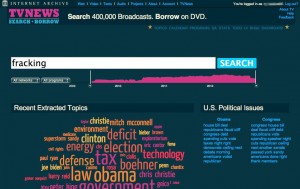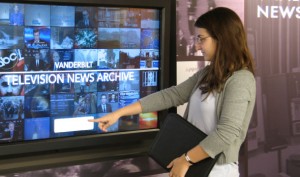Thanks to a recent $1 million grant from the John S. and James L. Knight Foundation, we will be expanding our TV News Search & Borrow service that enables everyone to search, quote and borrow U.S. television news programs.
Launched last September, the service repurposes closed capti oning to facilitate deep search and present relevant short-streamed with clips from more than 400,000 news broadcasts dating back to June 2009. We are striving to help inform and engage communities by strengthening the work of journalists, scholars, teachers, librarians, civic organizations and others dedicated to serving public interests.
oning to facilitate deep search and present relevant short-streamed with clips from more than 400,000 news broadcasts dating back to June 2009. We are striving to help inform and engage communities by strengthening the work of journalists, scholars, teachers, librarians, civic organizations and others dedicated to serving public interests.
We are beginning to see important public benefits arising from this new capability to apply digital search and a nalysis to news from our most pervasive and persuasive medium—television. Journalists are better able to investigate significant persons and events. Documentarians are more effectively finding key news footage to license and use. Educators can now focus the critical attention of their students on extensive real-world examples of how news stories are told and audiences engaged.
nalysis to news from our most pervasive and persuasive medium—television. Journalists are better able to investigate significant persons and events. Documentarians are more effectively finding key news footage to license and use. Educators can now focus the critical attention of their students on extensive real-world examples of how news stories are told and audiences engaged.
We recently worked wit h researchers at Harvard’s Berkman Center and MIT’s Center for Civic Media to facilitate direct machine queries of our television news library that returned structured data results to inform their media landscape analysis of the Trayvon Martin story and reveal key pivot points in its evolution.
h researchers at Harvard’s Berkman Center and MIT’s Center for Civic Media to facilitate direct machine queries of our television news library that returned structured data results to inform their media landscape analysis of the Trayvon Martin story and reveal key pivot points in its evolution.
Journalists and documentarians at the newly-launched Retro Report are using TV News Search & Borrow to help them take a fresh look at important stories of the past, share new perspectives and add insightful commentary to what are sometimes all too shortsighted first drafts of history.
We are also working with a number of scholars, journalists and civic organizations to see how our research library might help improve political accountability and transparency by indexing television political advertising and pairing them with information on ad sponsors from FCC-mandated “public inspection files” at each station.
 “Daisy“
“Daisy“
Such a special collection could also be used to study interactions between campaign messaging and local news coverage. The 2013 elections in Virginia, a state with no political campaign contribution limits, may be a useful test-bed for experiments like these.
We are following up on suggestions from media professionals that a comprehensive research library of local television news might also better inform stations and their audiences about how programs are helping to meet the critical information needs of local communities.
 Our TV News Search and & Borrow service preserves and makes responsibly accessible an enduring library of television news, serving important public benefit research interests of today and those of generations to come. In doing so, it stands on the shoulders of the pioneering work of Vanderbilt University’s Television News Archive and, more recently, UCLA’s NewsScape library.
Our TV News Search and & Borrow service preserves and makes responsibly accessible an enduring library of television news, serving important public benefit research interests of today and those of generations to come. In doing so, it stands on the shoulders of the pioneering work of Vanderbilt University’s Television News Archive and, more recently, UCLA’s NewsScape library.
We are humbled by the challenges of exploring the new territory of scaling intelligent access to our growing digital public library of television news and welcome feedback on how we can better serve the public interest.
Congrats! Glad to see support for such a crucial project.
Pingback: Internet Archive Receives $1 Million Grant From Knight Foundation to Expand TV News Archive | LJ INFOdocket
Pingback: Internet Archive gets $1M donation for ambitious broadcast TV archive project | Richmond SF Blog
Well, this does sound fantastic, but a good part of the collection (that SHOULD be on the ‘web, but probably won’t be until the Three Rocks* give up their dream that old TV, including old news, all @150 episodes of the late Jay Ward’s (Rockey and Bullwinkle in) “Jet Fuel Formula” downloaded for purposes of research, increasing the entropy of the universe or personal entertainment) have some value. It is kept locked in a pair of museum vaults, where viewers can pay $10 a visit, to watch or listen for up to 2 hours a day, on (last time I was there) lousy little monitors on tapes offered with NO color correction for faded analog quality, and a lot of paranoia that copyrights will be violated!
It is my dream that the Paley Center, formerly the Museum(s) of Radio and Television, NYC and LA, formerly the Museum of Broadcasting, until the ghost of the guy who fired Murrow and Friendly took over, would simply ask for, and probably receive grants needed to digitize a collection that should grow daily, with news archives enlarged on a daily basis with additions from the ‘Rocks and PBS (and 24/7 events from both the networks, the world’s news channels, and “news channels” whether run by Kim Jong Il or Roger Ailes,(is there really a difference?) and release shelf-miles of arts and “entertainment” material which will never be saleable for profit either on DVD or download (considering the cost of digitizing, color correction, indexing v. the value of donation to a 501(c)3 Educational NfP) and putting about 99% of what remains of commercial broadcasting at the fingertips of anybody who wishes it (paranoia of loss of copyright and protections offered by the DMCA, aka the “Sony Bono”** act are the twin reasons not one other-than-home-brew regular Blue Ray TV format recorder has arrived to replace the VCR except in Japan! And I really miss the ability to easilly record things that I, at least, consider interesting.).
I mean I have a strong urge to own a restored digitized copy of the PBS 1973 broadcast of the Yale Rep. Theater Co.’s production of Leonard Bernstein’s “Mass”. Last time I saw the Only Available Copy – color-faded film-to-tape cartridge at the MB (name changed to protect museum-goers looking for collections of old electronics) on a 12″ not-even-flat-crt in ’bout 1995, I was watched to make sure I didn’t have a pair of sound-recording mics jammed into my ears.
A bid to get a copy of Dick Gregory’s May 4, 1971 speech at Kent State University (a year after the shootings) was a statement from the university archivist that it doesn’t matter that it was made outdoors to untold thousands of people – and that anybody present could hear and record the culmination of a memorial for the four victims of never-prosecuted state-sponsored murders – was a copyrighted performance by Mr. Gregory and could not be released.
Just a couple of my strange desires for my personal video library, which probably won’t be fulfilled in my lifetime.
nNM
The late Newton Minnow was the FCC chairman who called effectively-12-channel TV a “vast wasteland”. Aside from a few “improvements” mainly in next year’s near-4K-line technology – likely to become as popular as sideband digital AM & FM radio has, because there has been no legal mandate that all AM-FM receivers made access this technology – the major change is we now have 500 to 1,000 channels of crap to choose from.
*The 3 Rocks -30 Rockefeller Plaza, home of NBC, Blackrock – the granite-tower home to CBS, and LittleRock, the network nobody thought would make it, ABC, formerly the NBC Red Network until anti-trust action blocked RCA from owning two networks out of only four or five (DuMont and Mutual among them) – PBS went on the air 51 years ago as National Educational Television, as Murrow, hired to head the organization after he became too “controversial” for Bill Pailey of CBS because he did real news, declared NET would be the only television offering both quality “and no commercials.” 1 out of 2 wasn’t a bad half-century prediction.
**The particularly vile and practically prima facia unconstitutional extension of US copyright laws was going to be named after bad comedien and skier (COUGH) Congressman Sonny Bono until he was hit by a misplaced tree. those with a little legal Latin know that IP lawyers across the land want the bill named for its true K-Street creator as “good for Sony Corp, which has gobbled up most of the US record labels beginning with the grand CBS collection, and not owned by BMG, which began collecting labels when GE bought RCA-Victor and tossed out what it saw as unprofitable – now being challenged by Apple and its friends, providing 7-day chart-topping pop to people who think of “sound quality” the way
60s kids did with a cheap plug in one ear from their cheap AM radios – i.e. worse than CD compression, which begins by cutting out the top 4KHZ a human can hear, then gets worse)